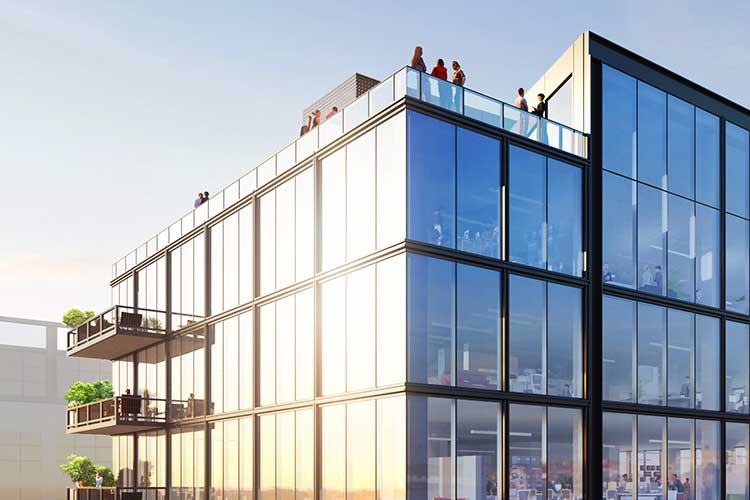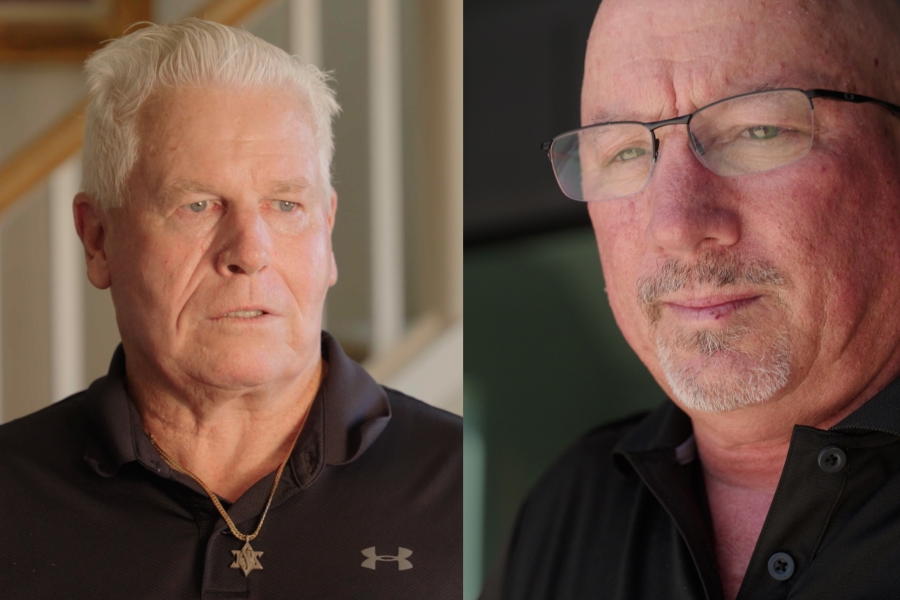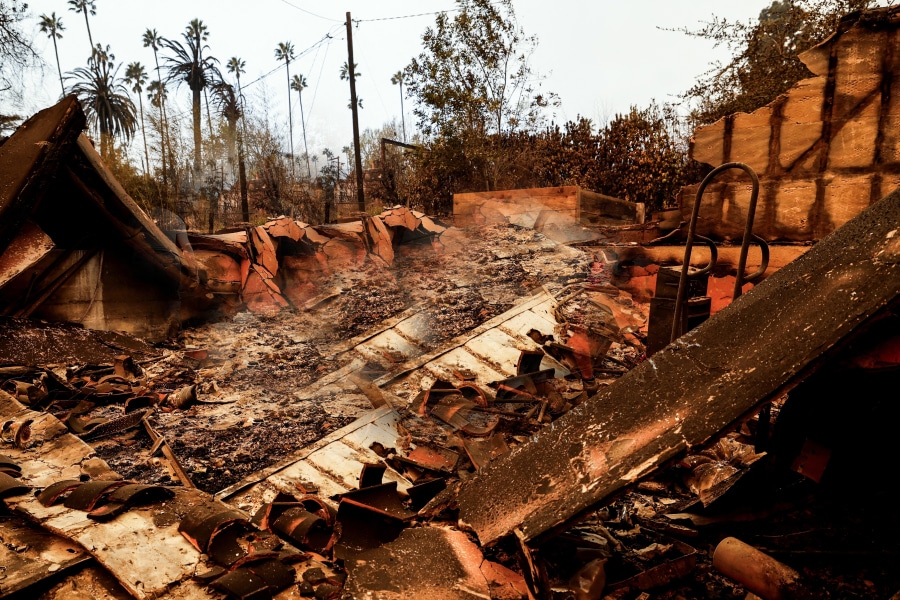When workers eventually return to their offices following an extensive remote work period due to the COVID-19 pandemic, they will find their at-office experiences sharply circumscribed by protective processes and procedures designed to prevent the spread of the novel coronavirus and the next wave of pathogens. Workers also may find their office environments themselves have been transformed.
To date, some major companies have announced return-to-office plans as far out as August 2021, while others have said remote work will remain indefinitely. Despite the real possibility that the pandemic-driven work-from-home experiment is likely to upend decades-long norms around in-office work, some office space developers aren’t wasting time in planning for a post-COVID world.
A wave of investments in building retrofits promise employees that do return to offices sooner rather than later cleaner air, easier social distancing and more ways to avoid touching communal, potentially virus-tainted surfaces. A newly opened office tower in Chicago is being marketed as among the first buildings designed with this reality in mind.
Fulton East, a 12-story, 90,000-square-foot office and retail building at 215 North Peoria Street in Chicago’s Fulton Market District, offers state-of-the-art wellness technology and modest 10,605-square-foot floor plates to enable flexible, custom planning options designed to allow safe social distancing.
The building also features touch-free elevators, with foot-activated call buttons, motion-activated washroom fixtures and the kind of air purification technology normally featured in medical facilities.
But Fulton East, the first from-scratch project for Chicago’s Parkside Realty Inc., was designed using health-focused alternatives to what had become standard office design practices before developers ever became aware of the nascent pandemic emerging from Wuhan, China, in late 2019.
Biophilic design
“In the West Loop-Fulton Market area, developers have been going for giant floor plate buildings—40,000- to 50,000-square-foot floor plates—to appeal to tech firms that have been putting people in benching situations, seating people right next to each other,” said Bob Wislow, a veteran commercial real estate developer and investor who started Parkside Realty in August 2019. “We took a completely different approach.”
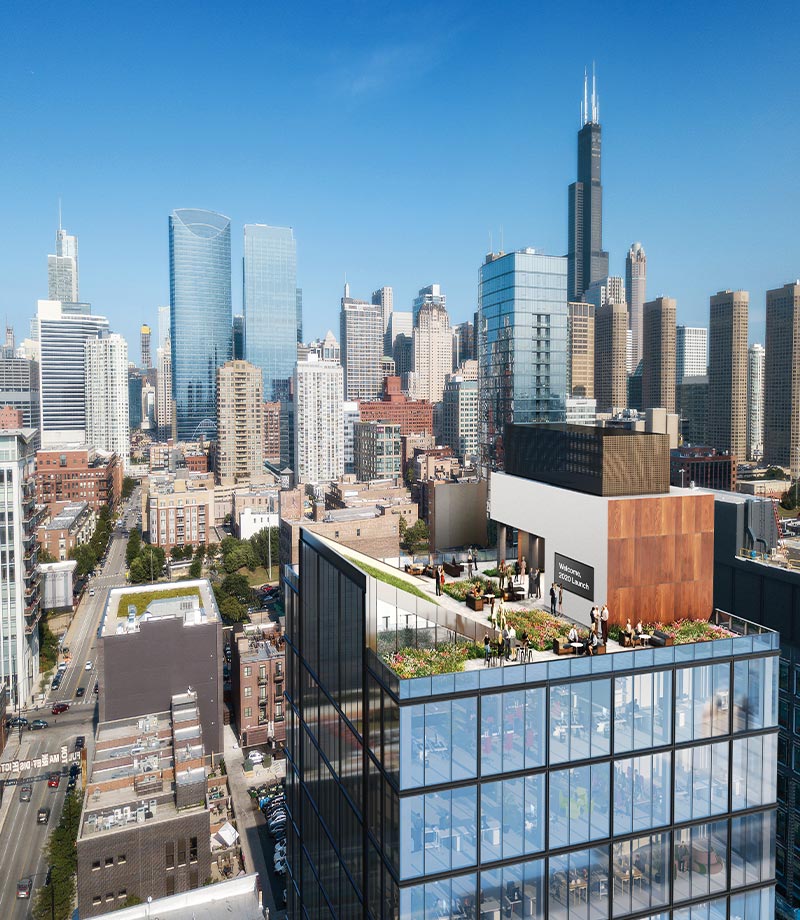
Wislow’s concept was to provide more human-scale offices, bringing nature into the building. “We wanted a ‘biophilic design’—a smaller floor plate, where you can have a higher ratio of exterior window wall, with outdoor space on every floor, and less densely populated,” Wislow said. “A tenant could take several floors of space and not have to share their corridors or washrooms with any other tenants.”
The building facade of Fulton East incorporates continuous, floor-to-ceiling, Low-E glass and 12-foot floor-to-floor spans to provide the maximum amount of light, air and views to benefit tenants’ health and well-being.
Then came the pandemic. “Our building should’ve been opened in late July 2020, but I took a really hard pivot and said, ‘Let’s push it back a few weeks and address the conditions of today’s market,’” he said. “We have a fiduciary responsibility to do that.”
Clean air, hands-free access
Wislow felt the most immediate priorities were to minimize the need for workers to touch dirty surfaces and to control ventilation to minimize the possibility of airborne virus transmission.
“We started researching how atmospheric air can be cleaned in a medical environment,” Wislow said. After researching an array of purification technologies, Parkside adopted airPHX, a non-thermal, plasma technology to reduce cross-contaminant risks and provide employees with cleaner air and work surfaces.
The airPHX (“air fix”) technology is currently used in hospitals, dental clinics, college athletic facilities and commercial settings where independent, on-site testing has shown reductions of 90-99% of viruses, bacteria and mold, both on surfaces and in the air.
‘We wanted a ‘biophilic design’—a smaller floor plate, where you can have a higher ratio of exterior window wall, with outdoor space on every floor, and less densely populated. A tenant could take several floors of space and not have to share their corridors or washrooms with any other tenants.’
Bob Wislow, Parkside Realty
“The airPHX device claims to clean both the air and surfaces and is the only technology we found that has extensive in place field testing supporting those claims,” Wislow said. “So, we adopted it for the entire building, and we are now retrofitting all of our other buildings with airPHX.”
Fulton East includes the world’s first new construction installation of MAD Elevator Inc.’s Toe-To-Go (T2G) hands-free elevator system. It’s also Otis Worldwide Corp.’s first-ever installation of the T2G elevator system, which uses foot-activated call buttons to reduce the spread of germs.
Fulton East also incorporates Sloan touch-free, solar-powered faucets, soap dispensers and flush valves, as well as SloanTec Hydrophobic Glaze on all vitreous washroom fixtures. “When the H1N1 flu outbreak happened in 2009, touchless washrooms became in vogue,” Wislow said. “I don’t think another major building will be developed without them.”
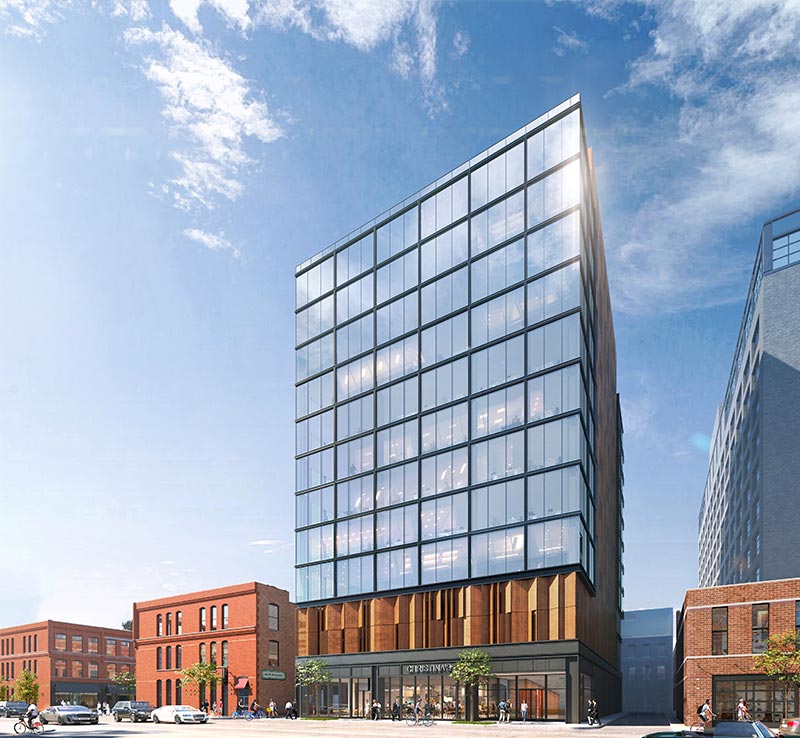
Finally, the building features antimicrobial paint in the washrooms. “I don’t know whether that’s ever been done in an office building before, but it’s typical in hospitals or dental clinics,” Wislow said. The paint is Sherwin-Williams Paint Shield®, an EPA-registered, microbicidal paint formulated to kill more than 99.9% of Staph, MRSA, E. coli, VRE and Enterobacter aerogenes within two hours of exposure on painted surfaces.
Other health-oriented design features include:
- Touch-free thermal scanning at the lobby security desk to check occupants’ temperatures
- Rosslare’s touch-free key fob access and security system, pre-wired for future Bluetooth Low Energy access via a mobile phone
- Butterfly, touch-free, after-hours security/building access/intercom/elevator access system
- Private, in-building, exclusive parking providing direct, touch-free, secure access to tenant floors
- Only three columns on each floor, enabling flexibility in office design to easily accommodate social distancing guidelines, including two distinct wet column areas providing the opportunity for two separated cafes and kitchens
- An 8,000-square-foot rooftop garden park available for the exclusive use of building occupants, offering comfortable seating for individual relaxation and small group meetings. Additionally, a spacious, amphitheater-style seating area with a large screen TV and state-of-the-art connectivity is available for comfortable outdoor presentations, training sessions, company meetings, entertainment and casual gatherings—all in a space designed to facilitate social distancing.
The long view
Wislow is no novice when it comes to commercial real estate, having first started in the industry in 1971. Since then, he’s experienced a lot of change, perhaps most notably the industry’s reaction to 9/11.
Wislow said the COVID-19 pandemic is likely to change the office real estate market. “Think about 9/11,” Wislow said. “I took over the management of what was then the Sears Tower—at the time the tallest building in the country—just after 9/11. The pundits were saying no one would ever sign a lease in that building again. We put in airport-like security—all kinds of ways to make the building safe. Every new building now of any size has done something similar.”
“I think in the same way, COVID is going to change the way we do things in office buildings permanently,” Wislow added. “Think about it: If you’re an average American 80 years old, you’ve spent 72 years of your life indoors. We already have tenants who in their requests for space included multipage requirements documents just devoted to asking how we deal with building air quality. I don’t think those questions are ever going to go away.”
Pandemic-focused features and improvements that address the immediate crisis will continue to differentiate buildings like Fulton East even after COVID-19 has passed, Wislow said, as pandemic preparedness will become more of a priority in the years to come. “Better air sanitizing will reduce colds and flu in the winter,” Wislow said. “And people are going to see that the investment in a healthier office environment improves wellness levels, reduces absenteeism and increases productivity.”

